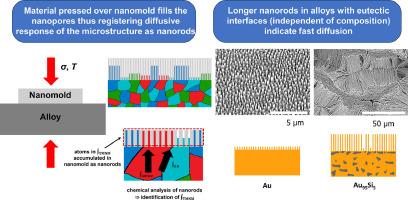用熔剂空间分离法直接测定合金中的扩散通量
IF 8.3
1区 材料科学
Q1 MATERIALS SCIENCE, MULTIDISCIPLINARY
引用次数: 0
摘要
尽管原子扩散在控制高温变形方面具有重要意义,但通常很难确定通过合金的扩散通量。我们提出了热机械纳米成型,其中纳米模具在应力梯度下由合金的扩散通量填充,以确定通过合金微观结构扩散的通量。这些通量被收集在纳米模具中形成纳米棒。形成的纳米棒的长度和组成分析使我们能够确定通量的速率和组成,并进一步允许估计该通量中成分的扩散系数。我们在金属和简单合金上验证了这一技术,然后揭示了一般合金中的扩散通量。值得注意的是,对于在其合金体系中可以获得共晶成分的合金,助熔剂的成分是共晶成分,这可能与合金的标称成分有很大不同。此外,通量的整体扩散系数也大大提高。这种迄今未知的共晶机制存在于大多数多组分合金中。这些对合金中扩散通量的见解可以用于指导具有特别低扩散率或特别高扩散率的合金的开发。更一般地说,提出的方法提供了一个新的工具箱,揭示了丰富的潜在的扩散控制合金变形机制。本文章由计算机程序翻译,如有差异,请以英文原文为准。


Direct determination of diffusion flux in alloys via spatial separation of flux
Despite the importance of atomic diffusion in controlling high temperature deformation, it remains difficult to generally determine diffusion flux through alloys. We present thermomechanical nanomolding, where a nanomold is filled by the alloy's diffusion flux under a stress gradient, to determine the flux diffusing through an alloy's microstructure. This flux is collected in the nanomold, forming nanorods. Length and composition analyses of the formed nanorods allow us to determine rate and composition of the flux, and further allow estimation of the constituents’ diffusivities in this flux. We verify this technique on metals and simple alloys, and then reveal diffusive flux in general alloys. Notably, for alloys that can access a eutectic composition in their alloy systems, the flux's composition is that of the eutectic, which can be very different from the alloy's nominal composition. Moreover, the flux's overall diffusivity is greatly enhanced. This, so far unknown, eutectic mechanism is present in the majority of multicomponent alloys. These insights into diffusion flux in alloys can be used to guide the development of alloys with particularly low diffusivity or particularly high diffusivity. More generally, the presented method provides a novel toolbox to reveal the rich underlying diffusion-controlled mechanisms of deformation of alloys in general.
求助全文
通过发布文献求助,成功后即可免费获取论文全文。
去求助
来源期刊

Acta Materialia
工程技术-材料科学:综合
CiteScore
16.10
自引率
8.50%
发文量
801
审稿时长
53 days
期刊介绍:
Acta Materialia serves as a platform for publishing full-length, original papers and commissioned overviews that contribute to a profound understanding of the correlation between the processing, structure, and properties of inorganic materials. The journal seeks papers with high impact potential or those that significantly propel the field forward. The scope includes the atomic and molecular arrangements, chemical and electronic structures, and microstructure of materials, focusing on their mechanical or functional behavior across all length scales, including nanostructures.
 求助内容:
求助内容: 应助结果提醒方式:
应助结果提醒方式:


